How the funeral of Pope Francis unfolded
The open-air mass was attended by an estimated 200,000 people including 54 heads of state and 12 reigning sovereigns.

Pope Francis, who died on Easter Monday at the age of 88, was laid to rest on Saturday morning in a funeral attended by world leaders, royalty and thousands of faithful in Rome.
The open-air mass was attended by more than 150 delegations, including 54 heads of state and 12 reigning sovereigns and an estimated total of 200,000 people, according to the Vatican.
Here is a timeline of what happened in the lead-up and during the funeral:
– 8.30am
Archbishops and bishops assembled in the Constantine Wing, a corridor adjacent to St Peter’s Basilica, wearing chasuble (the outer garment worn by clergy during services), alb, belts and a simple white mitre.
Priests and deacons also congregated in St Peter’s Square, outside the basilica, wearing a chasuble, alb, belt and a red stole.
World leaders, including US President Donald Trump, UK Prime Minister Sir Keir Starmer, French President Emmanuel Macron and Irish President Michael D Higgins, paid their respects at the Pope’s coffin inside the church before gathering in the square ahead of the service.
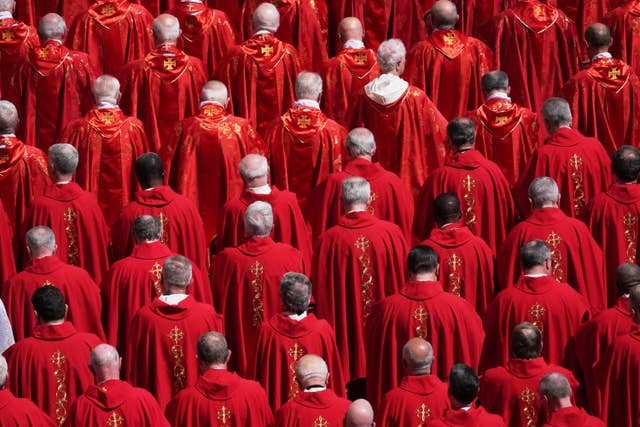
The Prince of Wales, dressed in a dark suit, arrived by car for the open-air ceremony and could be seen walking down the steps into the square from St Peter’s Basilica before shaking hands with a member of the clergy and being guided to his seat.
Sir Keir was accompanied by his wife Victoria and Foreign Secretary David Lammy, while Mr Trump was joined by his wife Melania.
Ukrainian President Volodymyr Zelensky appeared to receive a round of applause as he stepped out of the basilica.
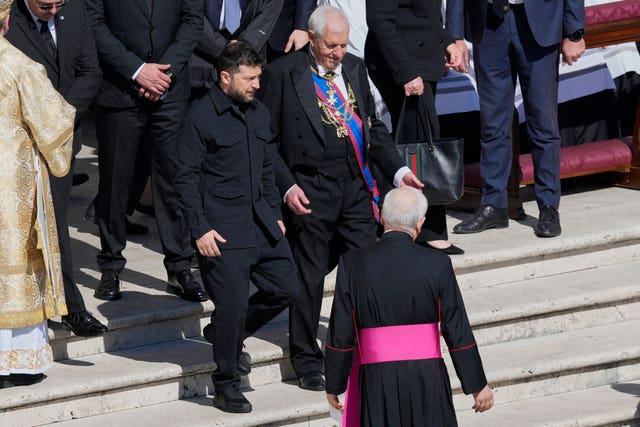
– 9am
The patriarchs and cardinals met in Saint Sebastian’s Chapel in the Basilica, wearing the white Damascene mitre before walking in the funeral procession alongside Francis’s coffin.
– 10am
At 10am local time (9am BST) the funeral began and the coffin was carried outside and laid in the square in front of St Peter’s Basilica.
The open-air service was presided over by Cardinal Giovanni Battista Re, Deacon of the College of Cardinals, and was televised worldwide.
Francis’s birth country Argentina took precedence in the seating, followed by Italy.
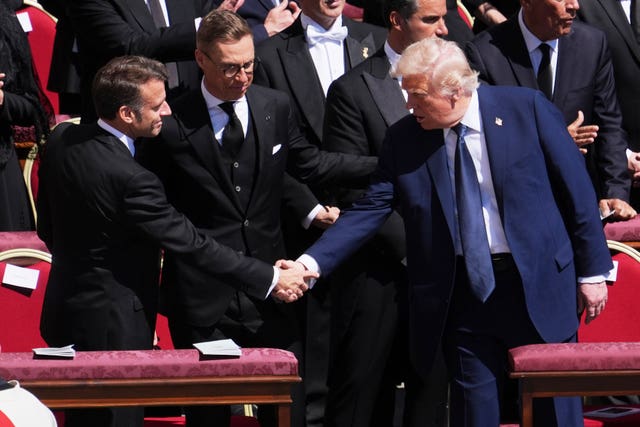
The reigning sovereigns were seated in alphabetical order in the French language, followed by heads of state.
The French language is used as traditionally French was considered the language of diplomacy.
The funeral followed the Funeral Rites of the Roman Pontiff and the guidelines set out in Universi Dominici Gregis, a document issued by Pope John Paul II in 1996.
The ceremony started with the entrance antiphon, a selection of psalm verses or scripture passages that are traditionally sung or recited, followed by the Penitential Act which allows the faithful to confess their sins to God before an opening prayer.
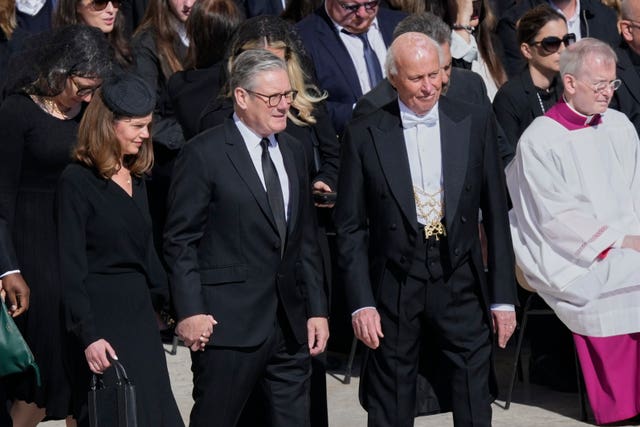
The first reading was given in English by Kielce Gussie, a journalist from Vatican News.
During a homily given in Italian, Cardinal Giovanni Battista Re described Francis as “a pope among the people with an open heart towards everyone”.
He paid tribute to the Pope’s “great spontaneity and an informal way of addressing everyone”, adding that he was “rich in human warmth and deeply sensitive to today’s challenges”.
Francis “incessantly raised his voice” for peace and urged people to “build bridges not walls”, the cardinal said.
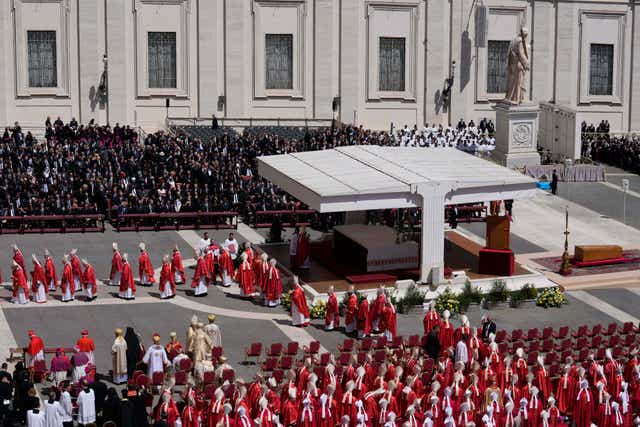
Of the Pope, he continued: “War, he said, results in the death of people and the destruction of homes, hospitals and schools.
“War always, this is his own expression, war always leaves the world worse than it was before. It is always a painful and tragic defeat for everyone.
“Build bridges, not walls, was an exaltation he repeated many times.”
Later in the service, Mr Trump and Mr Macron shook hands when the congregation was invited to offer those around them a “sign of peace” – a traditional part of the Roman Catholic mass.
At the end of the service, valedictory rite and final commendation, where the Pope is formally entrusted to God, took place.
Crowds gathered in the square applauded as the pontiff’s coffin was brought back into St Peter’s Basilica after the service.
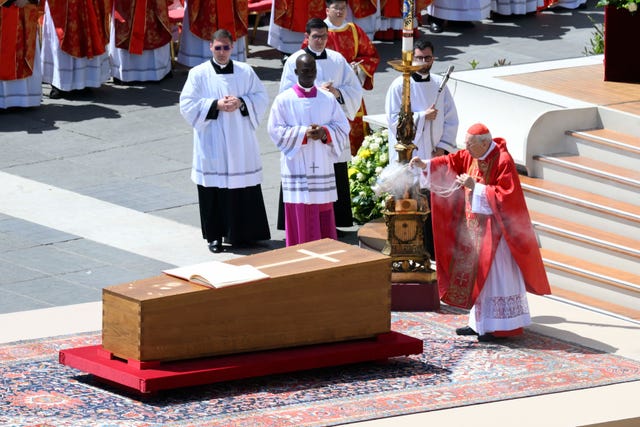
– 11.45am
Francis’s coffin was then driven from St Peter’s Square to Saint Mary Major Basilica, where he will be buried.
The route crossed the River Tiber and passed Piazza Venezia followed by the Colosseum.
Crowds lined the streets of Rome to pay respects to the Pope and applauded as the coffin was driven past in a white vehicle, similar to the open-top pope-mobile.
Francis left instructions asking to be buried in a simple underground tomb in Rome’s papal basilica of Saint Mary Major.
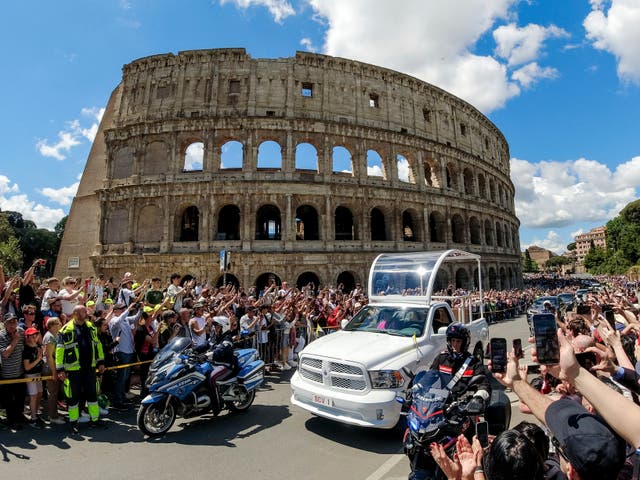
Upon arrival at the steps of the church, the coffin was received by what the Holy See previously described as a “group of poor and needy people”.
The burial will be held in private later this evening.
This makes Francis the first pontiff for more than a century not to be buried at St Peter’s Basilica. The last pope who asked to be buried outside the Vatican was Pope Leo XIII, who died in 1903.
The Vatican announced that people will be able to visit Francis’s tomb from Sunday morning.
The funeral marks the beginning of the Novemdiales, an ancient tradition of nine days of mourning and masses for the repose of the late Pope’s soul.
The Novemdiales masses will be held each day at 5pm local time in St Peter’s Basilica, apart from the mass on Divine Mercy on Sunday April 27, which will take place at 10.30am in St Peter’s Square.
The secret meeting of cardinals, known as the conclave, to pick Francis’s successor is expected to begin between 15 and 20 days after the Pope’s death.





